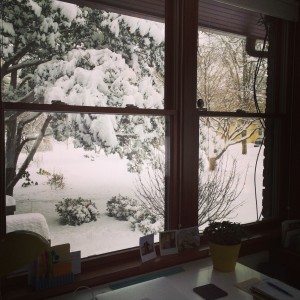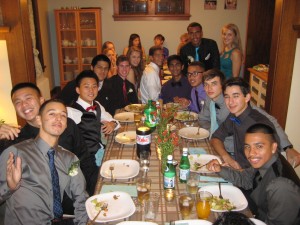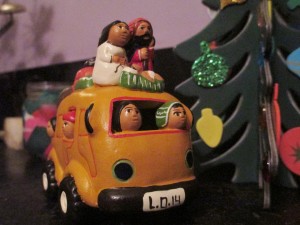I was born on the threshold of spring—at that moment when winter could just as easily dig in her heels as bow graciously and take her leave.
Over the years, the second day of March has skipped, tip-toed, sloshed, or trudged onto the scene of my life, accompanied by a wide variety of backdrops. Some years, the snow completely melts by then, inviting me to joyfully lace up new sneakers in place of clunky boots, and to take my coffee out to the porch.
I remember one spring-like childhood birthday in particular, because it was nice enough outside to go for a spin on my new birthday bike—a yellow banana seat Huffy with orange and white accents, called “Texas Rose” (bikes came with names back then, written in a suitable font across the chain guard). I still remember the clichéd-but-very-real freedom I felt as I pushed hard on the pedals to pick up speed, the wind lifting my bangs off my forehead and the handlebar streamers blowing back, tickling my arms. Even the puddles, spraying a mist of grimey specks onto my pants, were a joy to whiz through: The sound of bike tires cutting through puddles was the music of spring. Back in our driveway I engaged the kickstand, my Michigan winter legs trembling in response to the sudden demand placed on spring-and-summer muscles.
 Other years (like this year, for instance), heaps of snow have cruelly set my birthday scene. By early March everyone, of course, is longing for spring, but I tend to take its coy absence personally. I would gladly exchange all my birthday presents for an early departure of winter—for a walk on non-treacherous sidewalks in the sunshine, hat- and mitten-free, with the first signs of daffodils poking up through dead leaves. What could be a better gift than a promise that temperatures won’t fall below 50 again until fall?
Other years (like this year, for instance), heaps of snow have cruelly set my birthday scene. By early March everyone, of course, is longing for spring, but I tend to take its coy absence personally. I would gladly exchange all my birthday presents for an early departure of winter—for a walk on non-treacherous sidewalks in the sunshine, hat- and mitten-free, with the first signs of daffodils poking up through dead leaves. What could be a better gift than a promise that temperatures won’t fall below 50 again until fall?
 Instead, the likely reality in early March is something in between—neither here nor there, winter nor spring. In March you can often find me walking on the north side of the street, where the longer days of south-sweeping sunshine have melted the snow into slushy puddles and coaxed snowdrops, aconites, and crocuses out of hiding.
Instead, the likely reality in early March is something in between—neither here nor there, winter nor spring. In March you can often find me walking on the north side of the street, where the longer days of south-sweeping sunshine have melted the snow into slushy puddles and coaxed snowdrops, aconites, and crocuses out of hiding.
Soggy grass and brave flowers on one side of the street, dirty piles of snow and icy sidewalks on the other; I walk through March balanced in an awareness of what has been and what is to come.
* * * * *
As if taking a cue from the month of my birth, I tend to live my life at the intersection of realism and optimism—with an acute awareness of what is, but also a vivid understanding of what could be. The truth of the matter, as well as the hope. The now and the not yet. The lion and the lamb.
I grudgingly see the dirty piles of snow for what they are, but I know they’ll eventually become water to nourish flowers and lush green grass. The messy pile of boots by my front door, and the puddles and salt deposits they leave on the wood floor, will undoubtedly be replaced by sneakers and flip-flops, grass clippings and leaves.
 And the weight I feel—whether from so many layers of clothing and gear, or from built-up deposits of worries and regrets—will melt away, just as surely as the clouds will disperse and warmer streams of air will travel my direction, crowding out the chill. Suddenly, one bright morning, I will be able to see again who I am under all those layers of down and wool, and wondering and longing. I will see that I am a new creation, in process, again and again.
And the weight I feel—whether from so many layers of clothing and gear, or from built-up deposits of worries and regrets—will melt away, just as surely as the clouds will disperse and warmer streams of air will travel my direction, crowding out the chill. Suddenly, one bright morning, I will be able to see again who I am under all those layers of down and wool, and wondering and longing. I will see that I am a new creation, in process, again and again.




